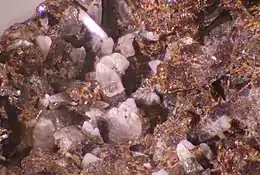Tilasite
Tilasite is an arsenate mineral gemstone, with the elemental formula CaMg(AsO4)F. It prefers the monoclinic form of crystal, and has Mohs hardness of 5. It was named in 1895 by Hjalmar Sjögren in honor of Daniel Tilas, who was once director of mines for Sweden, and a regional governor for Västmanland. It was first discovered in Langban, Varmland.[2]
 Grischunite and Tilasite: Well formed orange brown grischunite crystals associated to almost white tilasite crystals. From: Falotta, Tinzen, Grischun, Switzerland | |
| General | |
|---|---|
| Category | Mineral |
| Formula (repeating unit) | CaMg(AsO4)F |
| IMA symbol | Til[1] |
| Strunz classification | 8.BH.10 |
| Dana classification | 41.5.6.1 |
| Crystal system | Monoclinic |
| Unit cell | a = 6.681 Å, b = 8.950 Å, c = 7.573 Å β = 121.14° |
| Structure | |
| Identification | |
| Formula mass | 222.30 |
| Mohs scale hardness | 5 |
| Diaphaneity | Translucent |
| Specific gravity | 3.75 - 3.79 |
| Optical properties | Biaxial (-) |
| Refractive index | nα = 1.640 nβ = 1.660 nγ = 1.675 |
| Birefringence | 0.035 |
| 2V angle | 83° |
| Dispersion | relatively weak |
In 1972, Bladh et al. characterised samples found near Bisbee, Arizona.[3]
In 1994, Bermanec discovered centro-symmetric Tilasite near Nezhilovo, North Macedonia.[4]
References
- Warr, L.N. (2021). "IMA–CNMNC approved mineral symbols". Mineralogical Magazine. 85 (3): 291–320. Bibcode:2021MinM...85..291W. doi:10.1180/mgm.2021.43. S2CID 235729616.
- "Tilasite".
- Bladh K W, Corbett R K, McLean W J, Laughon R B. American Mineralogist 57 (1972) 1880-1884 "The crystal structure of tilasite" http://rruff.geo.arizona.edu/AMS/minerals/Tilasite
- Bermanec V (1994) "Centro-symmetric tilasite from Nezilovo, Macedonia: a crystal structure refinement" Neues Jahrbuch fur Mineralogie, Monatshefte 1994 289-294
This article is issued from Wikipedia. The text is licensed under Creative Commons - Attribution - Sharealike. Additional terms may apply for the media files.